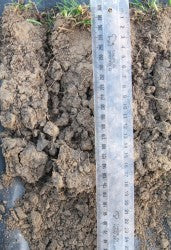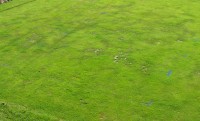Sports Field Best Use Modelling
 This project has been the main research focus for the past 18 months of Andrew Mitchell, our Research and Benchmarking Coordinator. The project has four key outcomes including development of a national database on sport field quality and performance, report on the main limitations to achieving optimal use, report on options for upgrading fields and a self-assessment tool for councils.
This project has been the main research focus for the past 18 months of Andrew Mitchell, our Research and Benchmarking Coordinator. The project has four key outcomes including development of a national database on sport field quality and performance, report on the main limitations to achieving optimal use, report on options for upgrading fields and a self-assessment tool for councils.
Picture left- Measuring ground cover - part of a field performance assessment.
Working with 8 councils from throughout New Zealand significant progress has been made towards completing the project objectives. A major outcome for the project is the development of the national database and gathering the associated sports field performance data and information from the councils. The participating councils have chosen 56 sports fields for performance testing and most of the fields have had three performance tests covering three seasons - winter, spring and summer. The participating councils have also been sent an extensive questionnaire which asks question about sports field provision, management and usage. The performance data and information provided by the councils, along with climate data, will be included in the database and used to develop t he models associated with the project. A computer services company has been contracted to undertake the database design and development and it is close to being complete.
he models associated with the project. A computer services company has been contracted to undertake the database design and development and it is close to being complete.
Picture right- Assessment of the soil profile - part of a field performance assessment.
The reports on limitations to achieving optimal use and upgrade options are still being completed but should be available to participating councils shortly. The report on limitations to achieving optimal use will also be available for general circulation to councils. The self-assessment tool will compose of many individual components that make up aspects of the other outcomes, such as the methodology for performance testing of sports fields, instructions for use of the database and options for upgrading, therefore much of this outcome is also complete, just requiring packaging up into a marketable product.
Other Research
Palmerston North
The two product evaluation trials, Fields 800 sand trial and Zeba soil amendment trial, established in 2007 at the Institute's Head Office Research Site are continuing.
Fields 800 Sand Trial
The Fields 800 is a trial of a new sand resource for use in sand carpets which contains approximately 5 percent biogenic shell material. The trial aims to compare the growth characteristics of three commonly used turf grasses (ryegrass, Cynodon and kikuyu) when grown in the Fields 800 sand with the same species grown in a proven "industry standard" sand. The trial has been regularly assessed for turf uniformity and density, weed content and turf colour.  Changes in the chemical properties of the sands and underlying soil have been monitored. Foliage samples have also been collected for analysis. The trial will run through the winter months to be completed in early summer 2008.
Changes in the chemical properties of the sands and underlying soil have been monitored. Foliage samples have also been collected for analysis. The trial will run through the winter months to be completed in early summer 2008.
Zeba Soil Amendment Trial
Picture left - Zeba soil amendment trial.
This trial is of a new soil amendment product called Zeba. Based on a natural material, Zeba is claimed to improve turf growth, decrease the watering needs of turf and reduce the incidence of localised dry patch. The aim of the trial is to evaluate the effectiveness of Zeba at reducing the extent of established dry patch, improving general turf quality and to determine its longer term effectiveness at preventing dry patch from reoccurring. The trial has been regularly assessed for turf quality, severity of dry patch and soil moisture content over the late summer and autumn of 2007 and again during the summer of 2008. This trial is due to be completed early in May 2008.
Picture right - Soil profile under a green area vs. dry patch area.
Soil profile under a green area vs. dry patch area.
Christchurch
Terranova Recycled Grass Trial
The Terranova trial involves an evaluation of ground recycled glass as a substitute for bunker sand and greens topdressing sand on golf courses. After several delays the trial in now well under way. Three Christchurch golf courses, Harewood, Windsor and Waitikiri, agreed to participate in the trial.
The bunker sand trials have been installed at each of the three courses. Waitikiri has a 50:50 mix of medium recycled glass and standard bunker sand. Harewood has a bunker with 100% light recycled glass and Windsor has a 50:50 mix of light recycled glass and standard bunker sand. Problems were experienced with the light recycled glass mix at Windsor, as it blew out of the bunker in high wind. This has been replaced. The performance of the recycled glass has been assessed regularly for surface hardness, moisture content, penetration resistance and light reflectance.
The green topdressing trial has been installed on the chipping green at Windsor Golf Club. The recycled glass has been applied following the same practices used on other greens on the course. The performance of the recycled glass as a top dressing material has been assessed regularly by recording turf quality, percent ground cover, green hardness, soil pH, penetration resistance, soil and surface temperature and player perceptions.
Both trials will continue run for a further five months.
Auckland
As mentioned in the last research update, the Institute was due to lose its Auckland Research Site at Cornwall Park Bowling Club. However, the fire in November 2007 has meant that we have lost our trial area sooner than expected. Staff are currently being housed in offices in Penrose with no immediate plans to find premises with a trial site attached.
Sources :- New Zealand Turf Managment Journal
